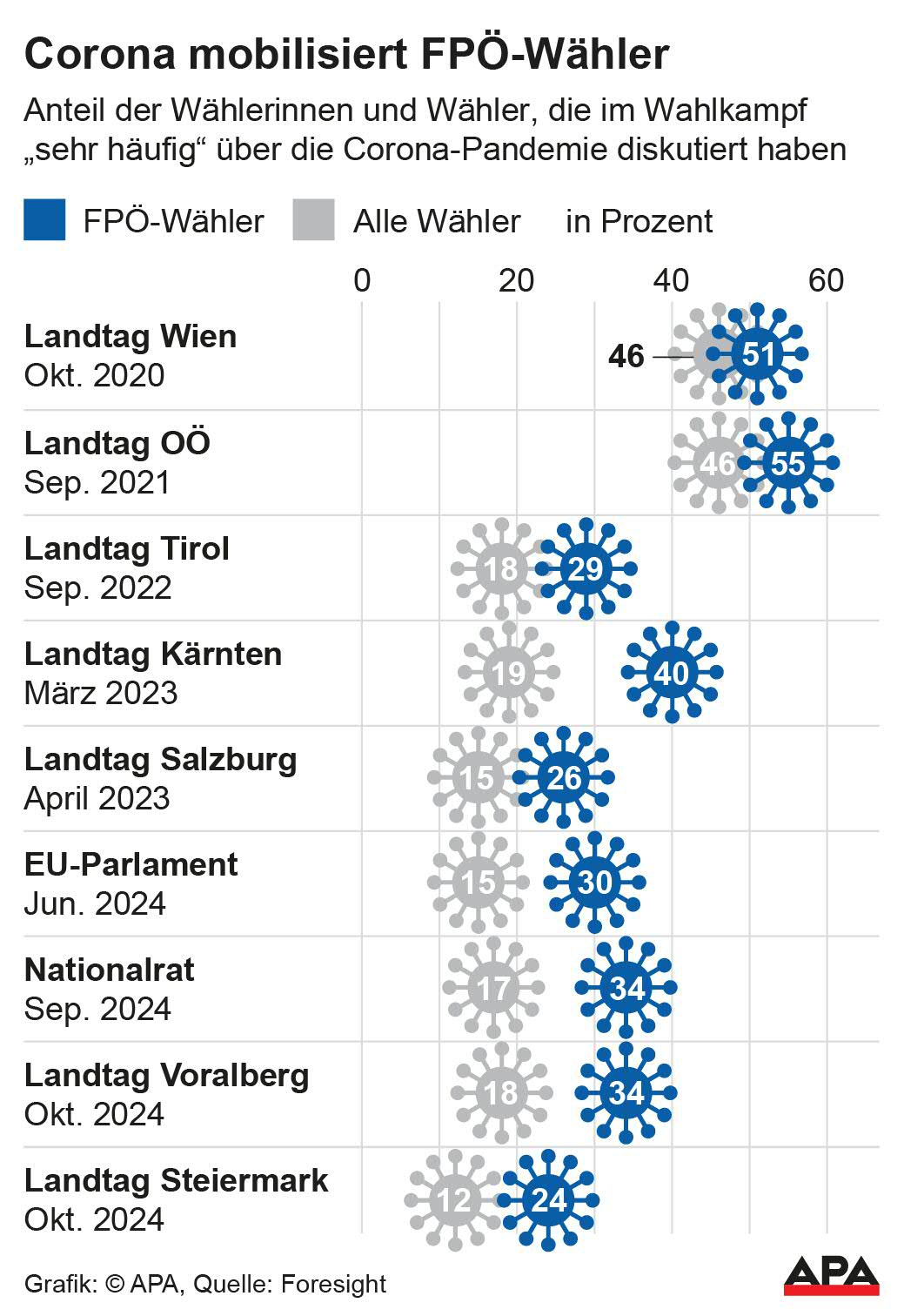Corona Pandemic Still a Topic for FPÖ Voters

Foresight, together with the Institute for Strategic Analysis (ISA), analyzes which topics are particularly often discussed in election campaigns for each election for the ORF. The Corona pandemic only reached first place in two state elections: in Vienna 2020 and in Upper Austria 2021. There, 46 percent of Upper Austrian voters said that the pandemic was very often discussed in the election campaign. Among FPÖ voters, this proportion was even higher (51 and 55 percent, respectively).
Corona Pandemic: Hard Blue Corona Shift
At that time, the FPÖ had already completed its hard shift in Corona policy: At the beginning of the pandemic, party leader Herbert Kickl had called for a strict lockdown to contain the pandemic. From April 2020, however, the FPÖ launched a populist campaign against the Corona measures, which continues to this day. The rise of the corona-skeptical party MFG was thus stopped by the Blues. But already in the Tyrolean state election in 2022, other topics dominated the election day surveys again - above all the inflation fueled massively by the rise in energy prices due to the Russian Ukraine war. "Inflation and rising prices" have since topped the list of topics in five out of seven elections, including the national election. In the EU election and the Vorarlberg state election, immigration was the most discussed topic.

For election researcher Julia Partheymüller from the University of Vienna, the national election, with the FPÖ's first election victory, was therefore more of a return to a "normal election." "The FPÖ already had 26 percent in 2017, now it has 28." The actual outlier, in her view, was the national election in 2019 with the FPÖ's crash after the Ibiza scandal. Now the "return movement" has occurred. "Corona played a role, but not as many people imagine," Partheymüller told the APA. The global rise of populist parties also did not take place during the pandemic, but afterwards: Covid was not a central success criterion for populist parties.
Christoph Hofinger from the Foresight Institute still sees a significant mobilization effect of the pandemic even almost two years after its immediate end. "The topic does not play a special role overall, but there is a part of the FPÖ voters for whom it is important," says Hofinger, looking at the election surveys. Here, 34 percent of FPÖ voters still stated in the national election that they had very frequently discussed "Corona" in the election campaign. Thus, the topic ranks only eighth on the blue list of topics, but almost on par with the economy and ahead of pensions. Such a topic could move a few percentage points, Hofinger believes, emphasizing "that it is not certain whether the FPÖ would have become number one on September 29 without this topic."
Higher Corona Mortality in Blue Strongholds
The effects of the FPÖ's Corona shift have been investigated by Patrick Mellacher from the University of Graz. He compared the survey results of the Austrian Corona Panel Project with the official Covid statistics. According to this, FPÖ supporters were united only in their dissatisfaction with government policy: An above-average proportion of FPÖ voters wanted (as demanded by Kickl) stricter measures, but many others already found the existing measures too far-reaching. After the FPÖ completed the shift to "Corona populism," the situation was clarified: FPÖ supporters stated significantly more often in surveys that they considered the danger to be exaggerated.
This is also likely to have led to the population in FPÖ strongholds more frequently ignoring containment measures - with corresponding health consequences. Mellacher compared the development of Corona deaths in individual districts with the FPÖ election result in the national election in 2019. Result: Districts with a higher proportion of FPÖ voters recorded more Corona deaths in the second wave of infections (i.e., after the blue Corona shift) than districts with fewer FPÖ supporters. "Especially for the winter wave 2020/21, there is a strong difference in mortality between FPÖ strongholds and districts where the FPÖ is less strong," says Mellacher.
Throughout Austria, a total of 23,390 people died from Covid-19 between 2020 and 2023. Mortality was particularly high in the winter of 2020. These figures are based on death certificates evaluated by Statistics Austria, so they only include people who actually died as a result of a Covid illness. Additionally, Statistics Austria registered 4,304 deceased in Austria between 2020 and 2022, where Covid was not counted as the cause of death, but as a concomitant disease.
(APA/Red)
This article has been automatically translated, read the original article here.





